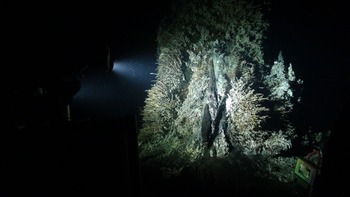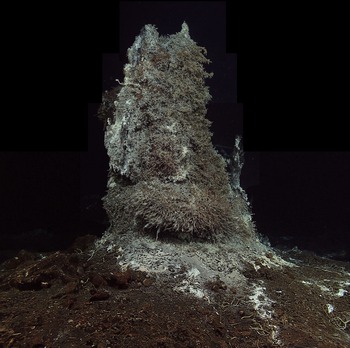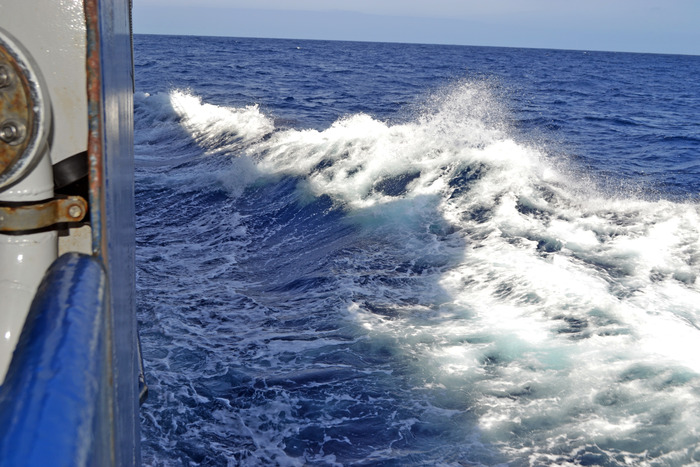
LED lights on the high definition camera, built by the Applied Physics Laboratory at the University of Washington, light up a > 1 m tall, young black smoker chimney at the base of the actively venting Mushroom edifice on Axial Seamount (water depth ~1500 m). The image, taken with the ROV Jason, shows the camera being tested by UW engineers during VISIONS16. They were in the Operations Center, located >300 miles to the east at the School of Oceanography. Here, they were commanding/controlling the camera live through the terrestrial and submarine Internet as part of the NSF Cabled Array infrastructure. Credit: UW/NSF-OOI/WHOI; V16.

The Mushroom hydrothermal chimney at the ASHES vent field, hosts dense communities of limpets, a variety of worms (palm, tube, scale, sulfide), and filamentous bacteria. The chimney rises ~ 4 m above the seafloor. This mosaic was compiled by M. Elend, University of Washington from several high definition images.
Following the completion of work at the Southern Hydrate Ridge methane seep site, the R/V Revelle transited to Slope Base to install an HPIES (horizontal electric field, pressure and inverted echo sounder) instrument that provides insights into the variability of currents and heat content of overlying ocean waters over large vertical extents. Jason dove to nearly 10,000 ft beneath the ocean to install this instrument on the National Science Foundation-funded Cabled Array and to recover the HPIES instrument installed last year. Once the vehicle was secured on deck, the R/V Revelle began its ~19 hr transit last night to Axial Seamount.
Many of us on the 03 deck were awoken about 0600 by a distinct change in ship movement – as in a distinct increase in pitching of the ship. We got up to beautiful blue skies with up to 25 knot winds (29 mph), which is not too bad for out here, but a definitely wave generator. It is beautiful on deck watching the seas and the skies. Waves pushed up from the bow of the ship sometimes result in rainbow-like colors in the spray from the wind-blown breaking waves. This is the first day we have seen the sun since leaving Newport on July 29. Sitting out on deck warms the soul.
Much of the team used the day to catch up on work, while many of the students used the time to catch up on sleep. Their excitement about the cruise results commonly in late nights spent talking about life and the expedition, working in the control room and on their projects and helping on deck - oh, and just like some of the Cabled Array team, there is that dreaded state called "being seasick". The students are a wonderful addition to the team and we appreciate having them out here.
We are all looking forward to diving at the hydrothermal fields at the summit of Axial Seamount tonight, weather permitting. We will install and recover a high definition camera at the actively venting hot spring called “Mushroom”, which is covered with animal assemblages that thrive in the perpetually dark waters. These systems are some of the most extreme environments that Earth has to offer, which is why they were chosen as key sites to instrument for the NSF Ocean Observatories Initiative Regional Cabled Array. The live video, as well as data from all cabled instruments can be accessed through the OOI data portal. During the installation, we will be streaming live video from Jason, as well as from the newly installed camera soon after it is plugged in. It is still amazing to think that an audience from around the globe can watch video, streamed at the speed of light into their living rooms, showing amazing and bizarre life forms that thrive on the top of a volcano over 300 miles off shore and 5000 ft beneath the oceans’ surface.


